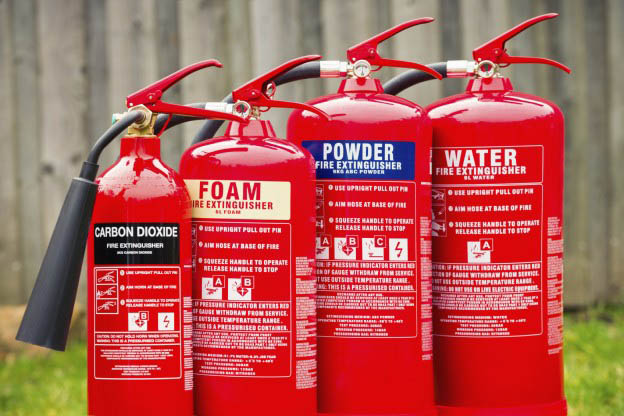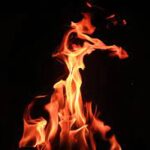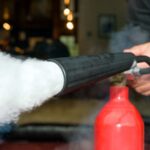Water Based
Foam Based
CO2 Based
CFC Based
Dry Chemical Based
Water Based
These are most effective on Class A fires.
On Class B fires, these are mostly ineffective. This is because, oil/petrol/gasoline etc. being lighter than water continues to float over water, and, thus, it continues to burn. In some cases, use of water based extinguishers on Class B fires could turn out to be injurious also. That is because, as water is thrown over burning fuel, the force due to water-stream could cause burning petrol etc. to be sputtered, and, this hot fuel could cause injury, if it falls on somebody.
On Class C fires, these should never be used. Use of water based extinguishers on Class C fires would surely be fatal. That is because, water is a good conductor of electricity, and, the electric current flows through the water-jet directly into the hands of the person who is holding the water-hose, resulting in immediate electrocution.
The way, these extinguishers work is: As water reaches the burning material – because of the high temperature, it vaporizes. While vaporizing, it extracts the latent heat from the burning element, thereby reducing the temperature. Besides, as it vaporizes, it expands. Usually, the expansion is in the order of 100 times (by volume). The need for higher volume of steam (vaporized water) displaces oxygen from the immediate vicinity of the burning material, thus, cutting off the oxygen supply.
Also, water being non-combustible material also tries to form a coating between the atmosphere (which is supplying the oxygen) and the combustible material.
Thus, it tries to reduce temperature, as well as displace oxygen, thus, attacking two arms of the fire-triangle, while, making a very feeble attack on the third arm also.
Foam Based
These are used mostly on Class B fires.
It can also be used on Class A fires.
These should never be used on Class C fires. The main constituent of foam being water – it can easily prove to be fatal on a Class C fire.
Foam being lighter engulfs the burning liquid. By covering the burning liquid, it cuts off the supply of oxygen to the burning material. Besides, the vaporization of water also helps in reduction of temperature – due to extraction of latent heat.
The basic principle is thus, similar to Water Based Extinguisher. The only difference is, foam stays above burning oil, thus, trying to engulf it – something that water could not do.
CO2 Based
These are mostly used on Class C fires.
It can also be used on Class A and Class B fires.
These kind of extinguishers might also be used to extinguish fires in computers, costly electronic equipments etc. where, usage of water etc. could cause damage to the equipment.
The biggest advantage of these kinds of extinguishers are that it does not leave any residue, smell or mess.
However, usage of these kinds of extinguishers in confined space could result in poisoning. Because, under lack of oxygen, carbon-di-oxide could act as a fuel, and, the resulting gas produced could be carbon-monoxide – which is highly poisonous.
The way these extinguishers work is: A stream of dry-ice (trade name for solidified carbon-di-oxide) is directed towards fire. Dry ice being very cold helps to reduce the temperature. Being heavy, carbon-di-oxide gas settles on the burning equipments, thus blowing away the oxygen – thereby cutting out the availability of oxygen.
Sometimes, the printed circuit boards (PCBs) of these electrical equipments could develop a crack, because the burning material which was hot is suddenly subjected to a very cold temperature (of dry ice). However, having a few cracks on a few boards might be a better choice than using water/foam, which will cause total short-circuit within the electrical circuit.
Carbon-di-oxide based extinguishers have an additional advantage. Being primarily gaseous in nature, the extinguishing agent can easily percolate inside machinery through fine slots (usually provided for ventilation/heat dissipation) on the outer casing of the equipments. So, it can be much more effective in fires which are inside the casing of electronic equipments.
CFC Based
These are mostly used on Class C fires.
It can also be used on Class A and Class B fires. The main difference between CO2 Based Extinguisher and CFC based extinguishers is that instead of carbon-di-oxide, it uses some inert gases, like: CFCs. These extinguishers also do not leave any residue, smell or mess. However, these are highly damaging to the environment (because of the tendency of CFCs to deplete the ozone layer). Many variants of CFCs are already banned. Some newer (and, cleaner) variants are already under consideration.
These extinguishers are very costly (both in terms of money as well as impact on environment), and hence, should be used only on very costly, specialty equipments.
The working of these equipments is very simple. They simply displace the oxygen at the burning site. And, these being highly inert gases – would not take part in any chemical reaction (including the process of burning), nor would let the burning material take part in the burning process – thereby extinguishing the fire.
These kind of extinguishers can also be used on metallic fires (Class D). Other extinguishers mentioned earlier could have mixed results on Class D fire, depending on which metal is burning.
Dry Chemical Based
These are most commonly used type of extinguishers.
It can be used on Class A, B and C fire. Hence, its popularly also called as ABC type extinguisher. Its impact on Class D fire could be varied, depending on the type of metal being burnt.
It works in the following way:
It stores dry yellowish chemical powder (mono-ammonium phosphate) under pressure of nitrogen gas (or, any other inert gas). When turned on, the dry powder is sprayed with pressure onto the burning material, along with the inert gas. Nitrogen displaces oxygen. The powder itself sits on the burning material – thus removing contact between burning material and its other two arms of fire.
The powder is a non-conductor of electricity – hence, its equally effective on Class C fire.


